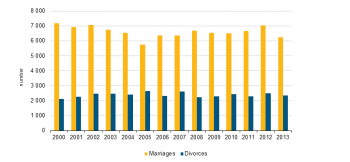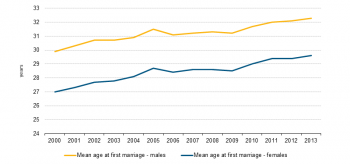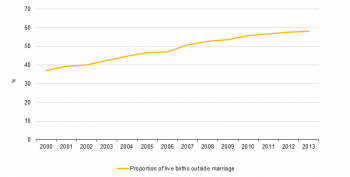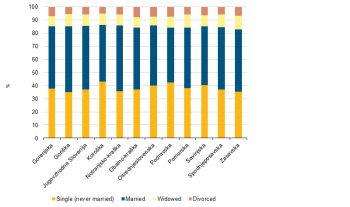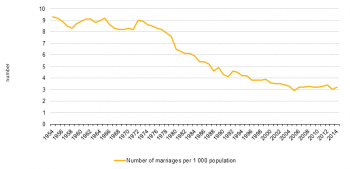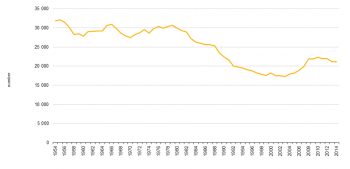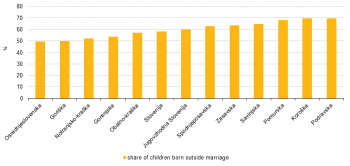Archive:Marriages and births in Slovenia
- Data extracted in Month YYYY. Most recent data: Further Eurostat information, Main tables and Database. Planned article update: (dd) Month YYYY(, hh:00).
Living as partners in Slovenia: marriages, divorces, children
Slovenia, too, – as most of the western countries – is faced with conditions in which the social role of the family in the classical sense is losing its primary importance. The number of marriages is declining, while the number of consensual unions and the number of children born outside marriage are growing. On the other hand, the ratio between the number of divorces and the number of marriages is rising.
Source: Statistical Office of the Republic of Slovenia
Main statistical findings
Marital status
In 2011, almost half (49 %) of Slovenia’s population aged 20+ were married, 35 % were single, 9 % were widowed and 7 % were divorced.
Marriages
In 2013, 6 254 marriages were recorded in Slovenia (see Figure 1). In the entire period since 2000 fewer marriages were recorded in 2005, 5 769. More than 7 000 marriages were recorded in 2000 (7 201), 2002 (7 064) and 2012 (7 057). The crude marriage rate was the lowest in 2005 (2.9 marriages per 1 000 population) and 2013 (3.0 per 1 000), and the highest in 2000 (3.6 per 1 000), and in 2001 and 2002 (3.5 per 1 000).
In 2013 the mean age of first-time grooms was 32.3 years, which is the highest mean age since 2000. Since then the mean age of first-time grooms has increased by 2.4 years. In the past 13 years first-time brides in Slovenia were on average 2.8 years younger than first-time grooms. Their mean age has also been rising; in 2000 it was 27.0 years and in 2013 29.6 years (see Figure 2).
Divorces
The number of divorces per 1 000 population did not change between 2000 and 2013. In Slovenia on average just over 1 couple per 1 000 population divorces. Most divorces (2 647) were recorded in 2005 and the fewest in 2000 (2 125). In Slovenia 2 351 divorces were recorded in 2013 (see Figure 1).
Consensual unions
The 2011 population census data show 122 496 consensual unions in Slovenia, which means that 7.4 % of the population aged 20+ is living in them.
Births
In 2013 the mean age of first-time mothers in Slovenia was 28.5 years. In 2000 it was 26.5 years, i.e. two years lower. The total fertility rate has also been gradually rising since 2000; in 2013 it was 1.55. It was the lowest in 2003 (1.20) and in 2001 and 2002 (1.21). After 2003 the rate started to rise. It was the highest in 2012 (1.58), when 21 938 children were born, while most children (22 343) were born in 2010. After 2010 the number of births slightly declined to 21 111 in 2013 (see Table 1). The fewest children (fewer than 18 000 per year) were born in 2001¬–2004. In Slovenia the share of children born to unmarried parents is rapidly growing; in 2000 it was 37 %, in 2007 for the first time more than a half (51 %) and in 2013 58 % (see Figure 3).
Special features in Slovenia
In 2014 the highest share of single persons in Slovenia was recorded in the Koroška statistical region (43 %), where one in four formally single inhabitants is living with a partner in a consensual union. Consensual unions have been a feature of the Koroška statistical region since the beginning of the 20th century. The lowest shares of single persons were recorded in Goriška and Zasavska statistical regions (35 %). The share of married couples was the highest in Primorsko-notranjska and Goriška statistical regions (50 %) and the lowest in the Podravska statistical region (42 %). The share of divorced persons was the highest in the Obalno-kraška statistical region (8 %)(see Figure 4).
Because women in Slovenia live longer than men, many of them are widows. At the end of 2014 two out of three women aged 80+ were widows. For comparison, among all women in Slovenia aged 15+ one in seven was a widow. Men in the highest age groups were mostly married in 2014; almost three quarters of men aged 80+ were married and a fifth of them were widowers.
Most of the people who in 2011 lived in consensual unions (41 %) were 30-39 years old; they were followed by people aged 40–49 (27 %). As regards their formal marital status, 80 % of people living in consensual unions were single, 14 % were divorced, 4 % were formally still married and 2 % were widowed.
The number of marriages in Slovenia is on decline
The number of marriages in Slovenia has dropped significantly over the past 60 years. In 1954, 14 126 couples were married and in 2014 only 6 571. The number of marriages per 1 000 population declined by three times since 1954; in 2014 the rate was 3.2 marriages per 1 000 population (see Figure 5). The fewest marriages per 1 000 population in 2014 were recorded in the Pomurska statistical region (2.9 per 1 000) and the most in the Posavska statistical region (3.6 per 1 000).
In 2014, 27 same-sex civil partnerships were registered in Slovenia (the most so far); 14 between two men and 13 between two women. After the Registration of a Same-Sex Civil Partnership Act was adopted in 2005 and came into force in July 2006, the number of same-sex civil partnerships has been gradually growing. In the 2006–2013 period on average 11 same-sex civil partnerships were registered each year (see Table 2).
Before divorce marriages last on average 14.1 years
The number of divorces has been growing throughout the period after WWII: from about 700 divorces in the first half of the 1950s to 2 500 divorces in 1985. This was followed by a ten-year period in which the number of divorces was falling. The lowest level was achieved in 1995 when 1 585 divorces were recorded or 0.8 per 1 000 population. Since 1995 the number of divorces has been rising again.
In 2014, 1.2 divorces per 1 000 population were recorded in Slovenia. The rate was the highest in the Obalno-kraška statistical region (1.5 per 1 000) and the lowest in the Koroška statistical region (0.9 per 1 000).
Before divorce a marriage lasts on average 14.1 years. In the past 20 years the number of those who divorced after they were married for more than 15 years increased the most (half of divorces in 2014). Very few divorces happened after the couple was married for less than a year (less than 1 % in 2014) (see Table 3).
The intensity of divorces is shown by the total divorce rate, i.e. the average number of divorces that lasted 0-30 years per one marriage. In Slovenia more than a quarter of marriages end in divorce, since the total divorce rate in 2014 was 0.30.
58.3 % children born to unmarried mothers
The number of live births in Slovenia has been declining for over 100 years. The decline was particularly intensive after 1980. The post WWII baby boom lasted up until the mid-1950s. At that time around 30 000 children were born each year; the rate was 20 new-borns per 1 000 population per year (in recent years the number has been cut in half). Around 30 000 children per year were born in the late-1970s and early-1980s when women born after WWII were having children. After 1980 the number of live births started to decline and in 1992 fell below 20 000. The fewest children were born in 2003 (17 321), and then the number started to slowly rise (see Figure 6).
According to the 2011 population census, in Slovenia a woman aged 15+ had on average 1.51 children. In 2011, the average number of children per woman was the highest in the Koroška statistical region (1.69 live births per woman) and the lowest in the Osrednjeslovenska statistical region (1.40 live births per woman).
The number of children born by one woman grows with age. The population replacement rate of over 2.08 children per woman was provided by generations of women born until the mid-1930s. Generations of women aged 40-44 years for whom it can be said that their fertility period has come to an end gave birth to between 1.7 and 1.8 children. Generations of women aged 20-30 years are entering their fertility period gradually: at age 29 half of women and at age 35 four out of five women are mothers. Half of women aged 40-69 had two children (see Figure 7).
Just over a quarter of women in Slovenia (26 %) have never given birth. Most of the women (39 %) gave birth to two children, 20 % of women gave birth to one child, 11 % of women gave birth to three children and 4 % of women gave birth to four or more children. Most women who gave birth to four or more children lived in the Koroška statistical region (6.4 %) and the fewest (2.3 %) in the Obalno-kraška statistical region.
In 2014, 58.3 % of children in Slovenia were born outside marriage. The number has been increasing since the 1970s. More than two thirds of first-born children were born to unmarried mothers. Consensual unions are becoming ever more frequent forms of living communities of young couples; this is confirmed by the fact that in 2014 about half of second-born children were born to unmarried mothers. With higher orders of birth the share of children born to unmarried mothers is falling, although in 2014 the share for third-born children was over a third. Most children were born outside marriage in Podravska and Koroška statistical regions (70 %) and the fewest in the Osrednjeslovenska statistical region (49 %)(see Figure 8).
The mean age of first-time mothers was the lowest in the Koroška statistical region (27.9 years) and the highest in the Osrednjeslovenska statistical region (29.9 years).
Context
TEXT
See also
- Name of related Statistics Explained article
- Name of related online publication in Statistics Explained (online publication)
- Name of related Statistics in focus article in Statistics Explained
- Subtitle of Statistics in focus article=PDF main title - Statistics in focus x/YYYY
Source data for tables, figures and maps (MS Excel)
Other information
Publications
- Stat'o'book
- We, the citizens of the EU
- People, families, dwellings
- The demographic portrait of Slovenia, 2008
[[Category:<Population>|Marriages and births in Slovenia]]
[[Category:<Statistical article>|Marriages and births in Slovenia]]
[[Category:<Marriages and divorces>|Marriages and births in Slovenia]]
